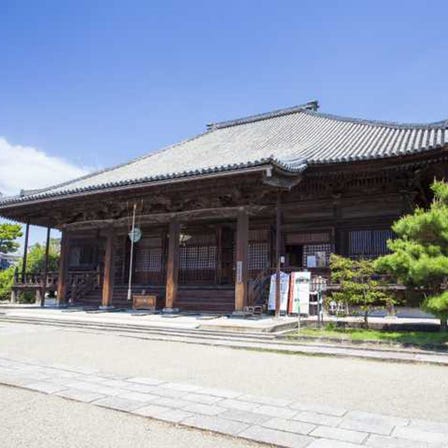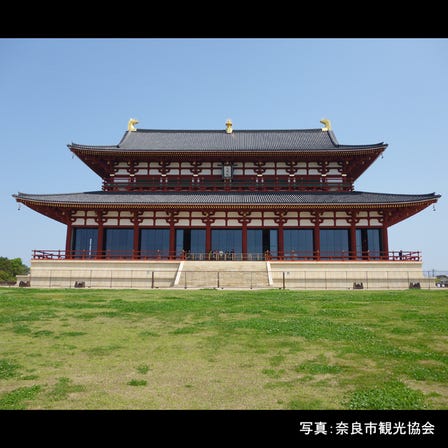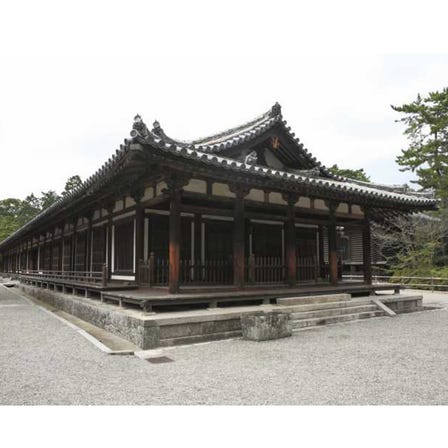Description
This is an ancient temple built in 680 upon the request of Emperor Tenmu to pray for the recovery of his sick wife (who later became Empress Jito). It was first built in Asuka, but was later moved to its current location when the national capital was moved to Heijokyo. All the buildings except for the East Pagoda were burned down in the 16th century during the war, but the Hakuho Garan Reconstruction Project that began in the 1960s restored the Chushin Garan (inner temple complex) in the original Hakuho Period style. The vibrantly colored structures are beautiful to see and reflect the rich culture of the Hakuho Period. The temple is also famous for the unique Buddhist lectures given by the monks to students on field trips. It was designated as a World Heritage Site by UNESCO as one of the Historic Monuments of Ancient Nara in December 1998.
・The Kon-do Hall of Yakushi-ji Temple was reconstructed during the Showa Period
As part of the Hakuho Garan Reconstruction Project that began in the 1960s, the Kon-do Hall was the first to be completed in 1976. This Kon-do Hall was built in a resplendent architectural style known as Ryugu-zukuri, characterized by the style of pent roofs known as mokoshi and a two-storied structure that looks like it has four stories from the outside. The vibrant red and green colors are beautiful to see and bring back the splendor of the Hakuho Period style in the present day. The Main Hall sits at the center of the Yakushi-ji Temple complex and enshrines the temple's main icons, the Yakushi Sanzonzo (triad image of Yakushi Buddha: Yakushi Nyorai flanked by Nikko Bosatsu and Gakko Bosatsu).
・The Reconstruction Project was supported by receiving donations in exchange for the opportunity to copy sutras
To help fund the Hakuho Garan Reconstruction Project that began in 1968, the temple received contributions from visitors in exchange for an opportunity to copy sutras. This practice, known as Shakyo Kanjin, is still continued today and visitors can copy sutras in the temple's sutra copying hall regardless of the individual's religion or sect. The sutras that are copied are stored inside the reconstructed temple buildings to be given eternal memorial services.
・Genjo Sanzo is memorialized through a large wall painting enshrined within the Genjo Sanzo-in Garan.
To the north of the Main temple complex lies Genjo Sanzo-in Garan (temple), which was constructed in 1991 to enshrine the posthumous image of Genjo Sanzo, whose teachings were principle to the founding of the Hosso Sect (he was also the model for the fictional monk Sanzo in ”Saiyuki”). The hall contains ”Wall Painting of the Great Tang of the Western Regions,” a huge painting measuring 2.2 meters by 49 meters that Ikuo Hirayama spent 30 years creating.
・The soothing sight of lotus flowers in early summer brightens Yakushi-ji Temple
Visitors can enjoy the lotus flowers that bloom within the temple complex every year from the end of June to the end of August. Around 250 pots of lotus flowers line the grounds, creating a beautiful contrast between the soft pink petals and the grand splendor of the temple buildings.
Location Information
-
- Address
-
457, Nishinokyocho, Nara-shi, Nara, 630-8563
-
- Nearest Station
-
Nishinokyo Station
・ Kintetsu-kashihara Line
1 minute on foot
-
- Phone Number
-
0742-33-6001Available languagesonly in Japanese
-
- Hours
- 8:30am - 5:00pm
-
- Closed
- None
-
- Public Site
- Official Site
Recommended Spots in Area
- Visiting
- Eating
- Shopping
- Lodgings





































